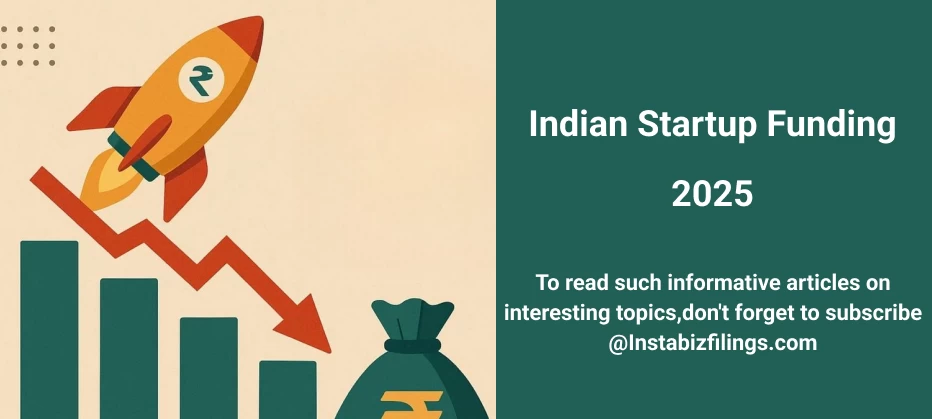
Indian Startup Funding 2025
October 17, 2025 by Team Instabizfilings
What 2025 looks like (headline numbers & big moves)
-
VC activity in India has recovered to the trough years and had strong momentum in the first half of 2025: startups in Q1 2025 above $3.1B, almost 41 percentage point improvement over prior Q1 2024 and with increased use of large late-stage investments and AI-focused investing.
-
In Indian startups, the number of startups that have raised about $5.7B (Inc42 H1 report) in H1 2025 (Jan-Jun), the largest portion of which were growth-stage and late-stage deals.
-
Longer view: 2024 was a recovery year in the VC funding market, where the year ended at 13.7B (Bain analysis) and will lead to further but selective activity in 2025.
-
Massive strategic investments and infrastructure bets expedited in 2025 such as Google declared an enormous multi-billion dollar AI/data-centre investment in India, which is an indication of more substantial global technology capital investment in the country.
What’s changed in 2025 the high-level trends
-
AI & Generative AI are dominant themes. A large share of capital (seed → growth) is moving into AI agents, developer tools, ML infra and verticalised AI (health, edtech, fintech). Q1 2025 identified AI agents as a top investment theme.
-
Concentration to fewer and larger deals. Even though the number of deals at the very early stages is decreasing, mega rounds (late-stage unicorn / pre-IPO) have also made a comeback, fueling aggregate dollar counts.
-
Deep-tech & climate/cleantech are rising. Capital is increasingly earmarked for hard tech (semiconductors, advanced manufacturing, climate tech) supported by policy incentives and grants. (See deep-tech coverage & Tracxn trend tracking.)
-
Greater inside and outside capital. Domestic capital and family offices and corporate strategic investors (including hyperscalers) are more prolific; global VCs are discriminating. An example of strategic infrastructure investment is the plan by Google to invest billions of dollars in artificial intelligence.
-
Rules (but specific rules are important). Start-up schemes, tax/hardship extensions and state incentives still apply; and the Finance Act has expanded some windows on start-up tax holidays until March 2025 and Start-up India has running programs. The founders would be advised to verify DPIIT/Startup India guidelines when making plans of grants/tax claims.
Where the money is going (sector & stage breakdown)
-
Industries that prompt us to invest: AI/ML tools & platforms, fintech (payments, BNPL, embedded finance), SaaS (B2B), healthtech, edtech (shifted to adult learning & upskilling), logistics & supply-chain tech, climate/energy tech and early stage semiconductor/robotics startups.
-
Stage dynamics: Late stage and growth rounds were up (a couple of mega deals make the totals look better), and seed/angel did some compression – investors are being more selective, wanting to see greater traction or defendable IP.
Notable 2025 deal types & big headlines
-
Global tech behemoths making headline-grabbing infrastructure investments (ie Google’s rumoured $15B in AI/data-centre plans) are a big signal for both ecosystem and data infrastructure.
-
A bunch of Indian startups joined the unicorn and near-unicorn ranks in 2025 across fintech, B2B SaaS and AI. Tracxn keeps a tab on the accelerating unicorn train of 2025.
Policy & programs founders must know
-
Formal recognition under Startup India / DPIIT still continues to bring in tax exemptions, easier compliance obligations and fast-tracked IPR process; holding documentation for claiming incentive on their taxes (eligibility of Section 80IAC).
-
Finance Act updates: The government has extended the timeline for certain startup tax holiday / incorporation eligibility until March 31, 2025. Be sure to check for exact applicability depending on the incorporation date and the claim window.
-
State level incentives & grants: Some states (Andhra Pradesh, Karnataka, Maharashtra, Telangana) now run targeted startup grants, incubator funding, and capital co-investment programs. So please research each state and check their portal for matching funds and land/infra benefits. (Refer to the Startup India state ranking pages.)
Who’s investing (types of investors & who to target)
-
International Venture Capitalists (selective, prefer late stage with traction)
-
Domestic VCs / growth funds (very active across stages with India unit economics familiarity)
-
Corporates venture and hyperscalers (strategic investments or infra partnership)
-
Family offices and HNIs (early stage and follow-on rounds)
-
Sovereign/strategic funds (sometimes work for big infra or deep-tech plays) Focus on the best investor type which best suits the stage, sector or exit horizon.
Practical fundraising playbook (founder checklist)
-
The key aspects of the metrics (data room) are the following: 12-18 months of financial forecasting, unit economics, CAC:LTV (Customer Acquisition Cost to Lifetime Value), churn, cohort metrics, ARR (Annual Recurring Revenue) or MRR (Monthly Recurring Revenue) if a SaaS product, burn runway, cap table.
-
It is essential to be clear about business milestones: explicitly explain what you want this round to fund (growth, product, hiring, or manufacturing) and what KPIs you will hit.
-
The items that should be prepared in the data room are the pitch deck, 3-year financial model, cap table (waterfall), shareholder agreements, ESOP (employee stock option plan) documents, legal documents (incorporation, contracts), IP assignments, customer references, term sheets (if relevant).
-
Targeted investors: Prepare a list of 20-30 potential investors matched by stage and sector, and realize that warm introductions significantly outperform cold introduction conversion rates.
-
Term sheet preparation: know the target valuation band, preferred vs common, liquidation preferences, anti-dilution provisions, board seats, pro-rata rights, and protective clauses. You should have a lawyer with experience in India VC rounds on board.
-
Plan for diligence: have one point of contact for diligence questions from investors, and have a live data room (Google Drive/Docsend) with controlled access.
Pitch deck 12 slide outline (what investors want)
-
Cover page with tagline (your business focus).
-
Challenge (identified users + supporting data).
-
Solution / product demonstration (screenshots).
-
Market size (TAM/SAM/SOM).
-
Business model (method to generate revenue).
-
Traction and metrics (growth, revenue, KPIs).
-
Competitive landscape and differentiation.
-
GTM (growth channels + unit metrics).
-
Technology/IP/moat (especially AI/deep-tech).
-
Team (founders + key hires).
-
Financials + use of funds (within next 18 months).
-
Ask + closing (amount, valuation band, milestones).
Term sheet & valuation quick rules of thumb (2025 realities)
-
Pre-money valuations depend on industry and traction; late-stage valuations are slightly more realistic than what was seen during the froth of 2021, and seed rounds may include more prudent pricing, unless there is extraordinary growth or technology/teams involved. Look at comparable rounds in your industry and geography. (If you want a factual valuation, check recent rounds of funding on platforms like Tracxn/Inc42/Crunchbase for comp.).
Exits & secondary market in 2025
-
The interest in IPOs in India is gradually in an upward trend; public markets in the late stage prefer to see profitable SaaS & capital efficient models . Secondary transactions (employee liquidity / tender offers by investors) are increasingly utilized for talent retention and continuity. Monitor large exchanges & recent IPOs for sectorial signals.
Funding risks & what to watch for
-
Global liquidity and macro factors influence Indian late-stage VC fundraising cycles.
-
The coherent investment strategy towards profitability or unambiguous, high-margin defensibility in unit economics is favored by investors.
-
Policy shocks: sectoral regulations (such as data and fintech regulations) could change valuations quickly based on compliance after consulting the legal team for sectorally-sensitive matters.
Actionable checklist for founders (ready-to-use)
-
Confirm product/market fit with 3 paying customers or at least 2X MRR growth compared to the last quarter (assuming you're a SaaS company).
-
Create a 12-slide deck and a one page teaser
-
Make a data room (legal, financial, product, customers)
-
Identify targets in the investor market: 20 out bonds, plus 5 warm intros.
-
Determine ideal and minimum raises, and have a plan to last 12 to 18 months
-
Have a lawyer, experienced with VCs, review a term sheet before you sign it.
Disclaimer
The information provided in this blog is purely for general informational purposes only. While every effort has been made to ensure the accuracy, reliability and completeness of the content presented, we make no representations or warranties of any kind, express or implied, for the same.
We expressly disclaim any and all liability for any loss, damage or injury arising from or in connection with the use of or reliance on this information. This includes, but is not limited to, any direct, indirect, incidental, consequential or punitive damage.
Further, we reserve the right to make changes to the content at any time without prior notice. For specific advice tailored to your situation, we request you to get in touch with us.


